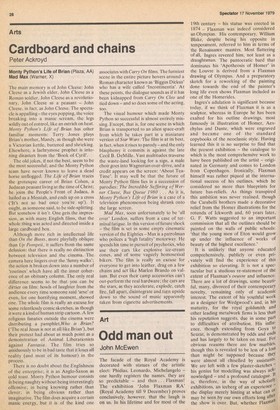Arts
Cardboard and chains
Peter Ackroyd
Monty Python's Life of Brian (Plaza, AA) Mad Max (Warner. X) 1 he main memory is of John Cleese: John Cleese as a Jewish elder, John Cleese as a Roman soldier, John Cleese as a revolutionary, John Cleese as a peasant John Cleese, in fact, as John Cleese. The spectacle is appalling the eyes popping, the voice breaking into a manic scream, the legs wildly out of control, like an ostrich on heat. Monty Python's Life of Brian has other familiar moments: Terry Jones plays Brian's mother, Mandy, as though she were a Victorian kettle, battered and shrieking. Elsewhere, a lachrymose prophet is intoning disasters from the 'Book of Cyril'.
The old jokes, if not the best, seem to be the most successful; and the Monty Python team have never known to leave a dead horse unflogged. The Life of Brian traces the grotesque career of Brian Cohen, a Judaean peasant living at the time of Christ; he joins the People's Front of Judaea, is hailed as a Messiah, and ends up on a cross ('It's not so had once you're up'). It ought, as someone said, to be side-splitting. But somehow it isn't. One gets the impression, as with many English films, that the whole thing was acted and directed inside a large cardboard box.
Although more rich in intellectual life than On the Buses, more playfully oblique than Up Pompeii, it suffers from the same delusion: that there is really no distinction between television and the cinema. The camera here lingers over the 'funny walks': the action is broken down into a number of 'routines' which have all the inner coherence of an obituary column. The only real difference seems to be that you can be dirtier on film: howls of laughter from the audience every time someone said 'arse' or even, for one horrifying moment, showed one. The whole film is really an excuse for some relentlessly comic sketches; as though it were a kind of human strip cartoon. A few religious fanatics outside the cinema were distributing a pamphlet,Who is Brian? (The real Jesus is not at all like Brian'), but their protest had about as much point as a demonstration of Animal Liberationists against Fantasia. The film tries so assiduously to be in bad taste that it loses all reality (and most of its humour) in the process.
There is no doubt about the Englishness of the enterprise; it is as Anglo-Saxon as cold toast. Monty Python humour consists .o in being naughty without being interestingly offensive; in being knowing rather than clever; in being obvious rather than imaginative. The film does acquire a certain manic energy, but it is of the kind one associates with Carry On films. The funniest scene in the entire picture hovers around a Roman character known as `Biggus Dickus' who has a wife called `lncontinentia'. At these points, the dialogue sounds as if it has been kidnapped from Carry On Cleo and tied down and so does some of the acting, too.
The visual humour which made Monty Python so successful is almost entirely missing. Except, that is, for one scene in which Brian is transported to an alien space-craft from which he takes part in a miniature version of Star Wars. The film is at its best, in fact, when it rises to parody -and the only blasphemy it commits is against the late Cecil B. DeMille. Vast multitudes traverse the waste-land looking for a sign, a male choir goes into Wagnerian over-drive, and a credit appears on the screen: 'About TeaTime'. It may well be that the future of Monty Python films lies in a succession of parodies: The Incredible Suffering of Werner Cleese, Bus Queue 1980 . . . As it is, Monty Python's Life of Brian is a case of a television phenomenon being shrunk onto the large screen.
Mad Max, soon unfortunately to be 'all over' London, suffers from a case of terminal fatigue. In this version of future shock the film is set in some empty cinematic version of the Eighties -Max is a patrolman who polices a 'high fatality' motorway. He spends his time in pursuit of psychotics, who use their cars like explosive ice-cream cones, and a some vaguely homoseival bikers. The film is really an excuse for everyone to get into leather, drag on a few chains and act like Marlon Brand° on vellum. But even their camp accessories can't out-perform the real hardware; the pars are the stars, as they accelerate, explode, catch fire, fall apart, disintegrate and turn upside down to the sound of music apparently taken from cigarette advertisements.






































 Previous page
Previous page